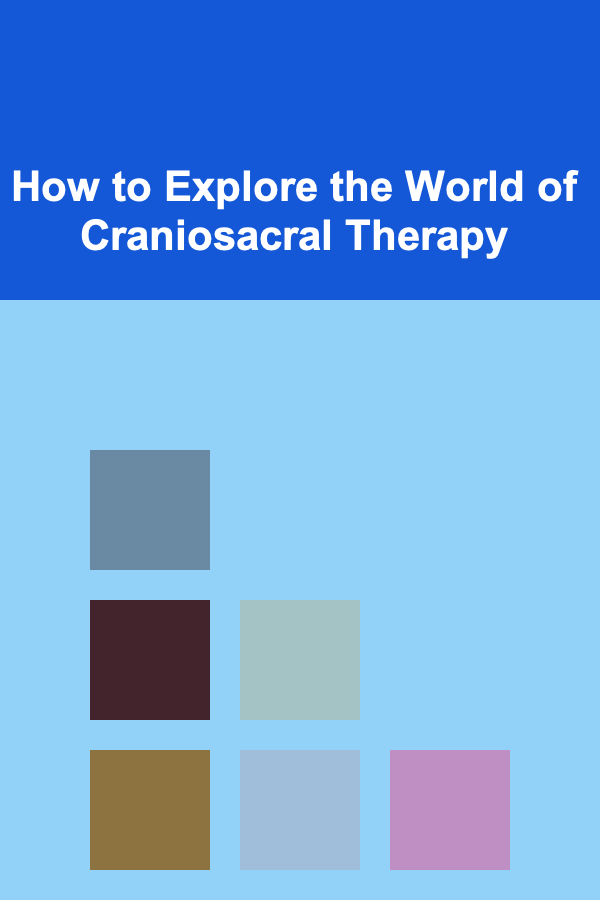
How to Explore the World of Craniosacral Therapy
ebook include PDF & Audio bundle (Micro Guide)
$12.99$9.99
Limited Time Offer! Order within the next:

Craniosacral therapy (CST) is a subtle, yet powerful form of bodywork that involves the manipulation of the craniosacral system, which consists of the membranes and fluid that surround and protect the brain and spinal cord. Despite its gentle and non-invasive nature, CST has gained recognition for its ability to address a wide range of physical and emotional issues, making it a unique and intriguing field of alternative medicine.
In this article, we will explore the world of craniosacral therapy in depth, including its origins, principles, techniques, applications, and how you can explore this fascinating field as both a recipient and a practitioner.
Origins and History of Craniosacral Therapy
Craniosacral therapy was developed by Dr. John Upledger, an osteopathic physician, in the 1970s. Dr. Upledger's journey into CST began when he observed the cranial rhythms of the skull during a surgical procedure. He noticed that the skull, which was traditionally thought to be rigid, actually demonstrated subtle, rhythmic movement. This discovery led him to further research and ultimately the development of CST as a therapeutic modality.
The foundations of CST, however, were rooted in earlier osteopathic principles established by Dr. William Sutherland in the early 20th century. Dr. Sutherland's work on cranial osteopathy paved the way for further exploration into the subtle movements of the craniosacral system. Dr. Upledger built upon Sutherland's teachings, refining the techniques and broadening the scope of application, eventually making CST more accessible to practitioners beyond the field of osteopathy.
Since its development, craniosacral therapy has gained traction worldwide, and its holistic approach to healing has attracted a growing number of practitioners and clients alike.
Understanding the Craniosacral System
To fully understand craniosacral therapy, it's important to comprehend the craniosacral system itself. The craniosacral system is composed of the following components:
- The Cranial Bones: These are the bones of the skull that protect the brain. Although they are fused in adulthood, they still exhibit slight, rhythmic movements.
- The Meninges: These are the protective membranes that cover the brain and spinal cord, providing a cushioning effect.
- Cerebrospinal Fluid (CSF): This fluid flows around the brain and spinal cord, acting as both a cushion and a medium for nutrient exchange.
- The Sacrum: Located at the base of the spine, the sacrum is considered the anchor of the craniosacral system, and its movement is integral to the fluid flow and rhythm of the system.
The rhythmic pulse of the cerebrospinal fluid is a key feature of the craniosacral system. This rhythm, which is typically around 6 to 12 cycles per minute, can be palpated (felt) by skilled practitioners during a CST session. The belief is that the health of the craniosacral system is vital to overall well-being, and any disruptions or imbalances in this system can lead to physical, emotional, and psychological issues.
Principles of Craniosacral Therapy
Craniosacral therapy is based on several key principles that differentiate it from other therapeutic approaches. These include:
1. The Body's Self-Regulating Mechanisms
CST is built on the concept that the body has an inherent ability to self-regulate and heal. Practitioners believe that by gently manipulating the craniosacral system, they can help restore balance and facilitate the body's natural healing processes.
2. Subtle and Gentle Touch
Unlike many other forms of bodywork, CST employs very light touch, typically no more than the weight of a nickel. This gentle touch allows the practitioner to connect with the body's rhythms without causing discomfort. This subtle approach can be effective in accessing deeper layers of tension and facilitating the release of physical and emotional blockages.
3. The Importance of the Craniosacral Rhythm
The craniosacral rhythm is central to CST. Practitioners use their hands to detect the subtle movements of the cranial bones and the flow of cerebrospinal fluid. By listening to these rhythms, they can identify areas of restriction or imbalance in the body. When these imbalances are corrected, the body is thought to be better able to restore its health.
4. Holistic Approach
CST does not isolate specific symptoms but instead considers the body as a whole. By addressing the root causes of discomfort or dysfunction, craniosacral therapy aims to promote overall well-being rather than just alleviating symptoms.
Techniques Used in Craniosacral Therapy
Craniosacral therapists employ a range of techniques to interact with the craniosacral system. While each session is tailored to the needs of the client, common techniques include:
1. Cranial Manipulation
This involves applying gentle pressure to the bones of the skull to facilitate the movement of cerebrospinal fluid and alleviate tension in the cranial membranes.
2. Sacral Release
The sacrum, at the base of the spine, is an important anchor point in the craniosacral system. Therapists may use gentle techniques to release tension in the sacrum and improve the flow of cerebrospinal fluid.
3. Inherent Motion
This technique involves feeling for the inherent motion or rhythm of the craniosacral system. Practitioners use their hands to detect these subtle movements, and then work with the body's rhythm to restore balance and release restrictions.
4. Myofascial Release
In some cases, CST can involve myofascial release techniques to address tension in the connective tissue that supports the body's structure. This technique helps to release restrictions in the fascia, which can improve overall movement and reduce discomfort.
5. Energy Work
Some craniosacral therapists integrate energy healing into their sessions. This may involve subtle energy work to clear blockages and enhance the flow of life force energy throughout the body.
Applications of Craniosacral Therapy
Craniosacral therapy has a broad range of applications, from physical to emotional and even spiritual healing. It has been used to treat a variety of conditions, including:
1. Physical Conditions
CST has shown efficacy in treating various physical conditions, such as:
- Chronic pain, including migraines and tension headaches
- Neck and back pain
- Postural problems
- Temporomandibular joint (TMJ) disorders
- Fibromyalgia
- Traumatic brain injury (TBI) and concussion recovery
- Digestive issues
- Sleep disturbances
2. Emotional and Psychological Issues
CST is not only beneficial for physical health but also for emotional and psychological well-being. Many people seek CST for issues such as:
- Anxiety and stress
- PTSD (Post-Traumatic Stress Disorder)
- Emotional trauma and unresolved grief
- Depression
- Chronic fatigue and burnout
3. Improved Well-being and Relaxation
Even for individuals without specific health complaints, CST can provide profound benefits. The deep relaxation and stress reduction achieved during a CST session can enhance overall well-being, promote better sleep, and improve focus and mental clarity.
How to Explore Craniosacral Therapy
Exploring craniosacral therapy involves understanding the theory, finding a qualified practitioner, and experiencing the therapy firsthand. Whether you're interested in CST for personal healing or are considering it as a potential career path, here are the steps to get started:
1. Research and Understand the Basics
Before you begin any therapy, it's important to understand what it involves. Read books, watch videos, and visit reputable websites to deepen your understanding of craniosacral therapy. Learning about its history, principles, and applications will give you a clearer perspective on how it can benefit you.
2. Find a Certified Practitioner
When seeking a craniosacral therapist, it's essential to find a licensed or certified professional with adequate training. Many practitioners are trained in CST through courses offered by institutions such as the Upledger Institute, which provides certification for craniosacral therapy. Look for practitioners who have completed reputable training programs and have a strong track record of success.
3. Schedule an Initial Consultation
Once you've found a certified practitioner, schedule an initial consultation to discuss your goals and concerns. During this meeting, the therapist will explain the process, answer any questions, and assess whether CST is the right approach for you. This is also a good time to share any relevant medical history or physical conditions.
4. Experience the Therapy
Craniosacral therapy is typically performed while the recipient lies fully clothed on a treatment table. The therapist will use light touch to engage with the craniosacral system, focusing on areas of tension or restriction. During the session, you may feel a sense of deep relaxation, warmth, or even emotional release. Sessions typically last between 45 to 60 minutes.
5. Evaluate Your Experience
After a few sessions, take time to reflect on how you feel. Many people report a sense of calm and well-being, both immediately following a session and in the days that follow. Keep in mind that the benefits of CST can be subtle, and it may take several sessions to experience significant changes.
6. Consider Training to Become a Practitioner
If you find craniosacral therapy to be an effective and rewarding practice, you might consider becoming a practitioner yourself. Training programs are available for those interested in learning CST professionally. These programs typically involve comprehensive coursework, hands-on practice, and mentorship. Once certified, you can begin offering craniosacral therapy to clients, contributing to their healing and well-being.
Conclusion
Craniosacral therapy is a powerful and gentle therapeutic modality that offers numerous benefits for both physical and emotional health. Whether you're seeking relief from chronic pain, emotional trauma, or simply looking for a way to enhance your well-being, CST may be a valuable tool in your healing journey.
By understanding the history, principles, techniques, and applications of CST, you can begin to explore this fascinating field with an open mind. Whether you are a recipient of therapy or interested in becoming a practitioner, craniosacral therapy offers a unique approach to health that emphasizes the body's ability to heal itself, providing profound and lasting benefits.

How to Make Money with Deep Learning Without a Large Investment
Read More
How to Stage Your Home for a Modern, Minimalist Look
Read More
The Supply Chain Analyst's Guide: Optimizing Efficiency and Performance
Read More
How To Navigate the Metaverse for Social Interactions
Read More
Engaging in Wildlife Art and Advocacy: A Deep Dive
Read More
How to Track Medical Expenses for Family Members
Read MoreOther Products

How to Make Money with Deep Learning Without a Large Investment
Read More
How to Stage Your Home for a Modern, Minimalist Look
Read More
The Supply Chain Analyst's Guide: Optimizing Efficiency and Performance
Read More
How To Navigate the Metaverse for Social Interactions
Read More
Engaging in Wildlife Art and Advocacy: A Deep Dive
Read More